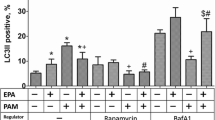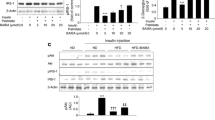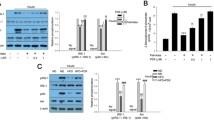Abstract
Palmitic acid, a main fatty acid (FA) in human nutrition, can induce apoptosis of cardiomyocytes. However, a specific combination of palmitic, myristic and palmitoleic acid (CoFA) has been reported to promote beneficial cardiac growth. The aim of this study was to investigate the relevance of CoFA for cardiac growth and to delineate the underlying signaling pathways of CoFA and palmitic acid treatment. CoFA treatment of C57Bl/6 mice increased FA serum concentrations. However, morphologic and echocardiographic analysis did not show myocardial hypertrophy. Cell culture studies using rat ventricular cardiomyocytes revealed an increased phosphorylation of AMP activated protein kinase α (AMPKα) to 155 ± 19% and its target acetyl-CoA-carboxylase to 177 ± 23% by CoFA. Treatment with myristic acid also increased AMPKα phosphorylation to 189 ± 32%. Palmitic acid did not activate AMPKα but increased expression of the FA translocase CD36 (FAT/CD36) to 163 ± 23% and adipose-differentiation-related-protein (ADRP), a sensitive marker of lipid accumulation, to 168 ± 42%. This was associated with an increased phosphorylation of the stress-activated-protein-kinase/Jun-amino-terminal-kinase (SAPK/JNK) to 173 ± 27%. In CoFA-treated cells, phosphorylation of SAPK/JNK was unaltered. FACS analysis revealed increased apoptosis to 159 ± 5% by palmitic acid but not by CoFA. AMPK activator AICAR (5-aminoimidazole-4-carboxamide ribonucleotide) prevented up-regulation of ADRP and increased apoptosis by palmitic acid. Confirming these findings, inhibition of AMPK by compound C in CoFA-treated cardiomyocytes resulted in an increased expression of ADRP to 154 ± 27%, FAT/CD36 to 167 ± 28% and apoptosis to 183 ± 12%. These data reveal that AMPK activation plays an important role in prevention of palmitic acid-induced apoptosis and lipid accumulation in cardiomyocytes.








Similar content being viewed by others
Abbreviations
- CoFA:
-
Combination of the FA palmitic, myristic and palmitoleic acid
- FA:
-
Fatty acid
- AMPK:
-
AMP activated protein kinase
- ACC:
-
Acetyl-CoA-carboxylase
- FAT/CD36:
-
Fatty acid translocase CD36
- ADRP:
-
Adipose differentiation related protein
- SAPK/JNK:
-
Stress-activated protein kinase/Jun-amino-terminal kinase
- AICAR:
-
5-Aminoimidazole-4-carboxamide ribonucleotide
- GLUT-4:
-
Glucose transporter 4
- BSA:
-
Bovine serum albumin
- TAC:
-
Transaortic constriction
- PPAR:
-
Peroxisome proliferator-activated receptor
- ROS:
-
Reactive oxygen species
References
Kemppainen J, Fujimoto T, Kalliokoski KK, Viljanen T, Nuutila P, Knuuti J (2002) Myocardial and skeletal muscle glucose uptake during exercise in humans. J Physiol 542(Pt 2):403–412
Calderone A, Takahashi N, Izzo NJ Jr, Thaik CM, Colucci WS (1995) Pressure- and volume-induced left ventricular hypertrophies are associated with distinct myocyte phenotypes and differential induction of peptide growth factor mRNAs. Circulation 92(9):2385–2390
Gidh-Jain M, Huang B, Jain P, Gick G, El-Sherif N (1998) Alterations in cardiac gene expression during ventricular remodeling following experimental myocardial infarction. J Mol Cell Cardiol 30(3):627–637
de Vries JE, Vork MM, Roemen TH, de Jong YF, Cleutjens JP, van der Vusse GJ, van Bilsen M (1997) Saturated but not mono-unsaturated fatty acids induce apoptotic cell death in neonatal rat ventricular myocytes. J Lipid Res 38(7):1384–1394
Drosatos K, Schulze PC (2013) Cardiac lipotoxicity: molecular pathways and therapeutic implications. Curr Heart Fail Rep 10(2):109–121
Stuck BJ, Lenski M, Bohm M, Laufs U (2008) Metabolic switch and hypertrophy of cardiomyocytes following treatment with angiotensin II are prevented by AMP-activated protein kinase. J Biol Chem 283(47):32562–32569
Kagaya Y, Kanno Y, Takeyama D, Ishide N, Maruyama Y, Takahashi T, Ido T, Takishima T (1990) Effects of long-term pressure overload on regional myocardial glucose and free fatty acid uptake in rats. A quantitative autoradiographic study. Circulation 81(4):1353–1361
Lehman JJ, Kelly DP (2002) Gene regulatory mechanisms governing energy metabolism during cardiac hypertrophic growth. Heart Fail Rev 7(2):175–185
Sambandam N, Lopaschuk GD, Brownsey RW, Allard MF (2002) Energy metabolism in the hypertrophied heart. Heart Fail Rev 7(2):161–173
Heggermont WA, Papageorgiou AP, Heymans S, van Bilsen M (2016) Metabolic support for the heart: complementary therapy for heart failure? Eur J Heart Fail 18(12):1420–1429
Utz W, Engeli S, Haufe S, Kast P, Hermsdorf M, Wiesner S, Pofahl M, Traber J, Luft FC, Boschmann M, Schulz-Menger J, Jordan J (2011) Myocardial steatosis, cardiac remodelling and fitness in insulin-sensitive and insulin-resistant obese women. Heart (British Cardiac Society) 97(19):1585–1589
Lopaschuk GD (2016) Fatty acid oxidation and its relation with insulin resistance and associated disorders. Ann Nutr Metab 68(Suppl 3):15–20
Dobrzyn P, Pyrkowska A, Duda MK, Bednarski T, Maczewski M, Langfort J, Dobrzyn A (2013) Expression of lipogenic genes is upregulated in the heart with exercise training-induced but not pressure overload-induced left ventricular hypertrophy. Am J Physiol Endocrinol Metab 304(12):E1348–E1358
Lopaschuk GD, Ussher JR (2016) Evolving concepts of myocardial energy metabolism: more than just fats and carbohydrates. Circ Res 119(11):1173–1176
Stapleton D, Mitchelhill KI, Gao G, Widmer J, Michell BJ, Teh T, House CM, Fernandez CS, Cox T, Witters LA, Kemp BE (1996) Mammalian AMP-activated protein kinase subfamily. J Biol Chem 271(2):611–614
Verhoeven AJ, Woods A, Brennan CH, Hawley SA, Hardie DG, Scott J, Beri RK, Carling D (1995) The AMP-activated protein kinase gene is highly expressed in rat skeletal muscle. Alternative splicing and tissue distribution of the mRNA. Eur J Biochem 228(2):236–243
Ponticos M, Lu QL, Morgan JE, Hardie DG, Partridge TA, Carling D (1998) Dual regulation of the AMP-activated protein kinase provides a novel mechanism for the control of creatine kinase in skeletal muscle. EMBO J 17(6):1688–1699
Liu WY, Jiang RS (2013) Advances in the research of AMPK and its subunit genes. Pak J Biol Sci PJBS 16(22):1459–1468
Kudo N, Gillespie JG, Kung L, Witters LA, Schulz R, Clanachan AS, Lopaschuk GD (1996) Characterization of 5′AMP-activated protein kinase activity in the heart and its role in inhibiting acetyl-CoA carboxylase during reperfusion following ischemia. Biochem Biophys Acta 1301(1–2):67–75
Luiken JJ, Coort SL, Willems J, Coumans WA, Bonen A, van der Vusse GJ, Glatz JF (2003) Contraction-induced fatty acid translocase/CD36 translocation in rat cardiac myocytes is mediated through AMP-activated protein kinase signaling. Diabetes 52(7):1627–1634
Glatz JF, Angin Y, Steinbusch LK, Schwenk RW, Luiken JJ (2013) CD36 as a target to prevent cardiac lipotoxicity and insulin resistance. Prostaglandins Leukot Essent Fatty Acids 88(1):71–77
Jeppesen J, Albers PH, Rose AJ, Birk JB, Schjerling P, Dzamko N, Steinberg GR, Kiens B (2011) Contraction-induced skeletal muscle FAT/CD36 trafficking and FA uptake is AMPK independent. J Lipid Res 52(4):699–711
Watt MJ, Steinberg GR, Chen ZP, Kemp BE, Febbraio MA (2006) Fatty acids stimulate AMP-activated protein kinase and enhance fatty acid oxidation in L6 myotubes. J Physiol 574(Pt 1):139–147
Russell RR 3rd, Bergeron R, Shulman GI, Young LH (1999) Translocation of myocardial GLUT-4 and increased glucose uptake through activation of AMPK by AICAR. Am J Physiol 277(2 Pt 2):H643–H649
Marsin AS, Bertrand L, Rider MH, Deprez J, Beauloye C, Vincent MF, Van den Berghe G, Carling D, Hue L (2000) Phosphorylation and activation of heart PFK-2 by AMPK has a role in the stimulation of glycolysis during ischaemia. Curr Biol CB 10(20):1247–1255
Sakamoto K, Zarrinpashneh E, Budas GR, Pouleur AC, Dutta A, Prescott AR, Vanoverschelde JL, Ashworth A, Jovanovic A, Alessi DR, Bertrand L (2006) Deficiency of LKB1 in heart prevents ischemia-mediated activation of AMPKalpha2 but not AMPKalpha1. Am J Physiol Endocrinol Metab 290(5):E780–E788
Riquelme CA, Magida JA, Harrison BC, Wall CE, Marr TG, Secor SM, Leinwand LA (2011) Fatty acids identified in the Burmese python promote beneficial cardiac growth. Science (New York, N.Y.) 334(6055):528–531
Miller TA, LeBrasseur NK, Cote GM, Trucillo MP, Pimentel DR, Ido Y, Ruderman NB, Sawyer DB (2005) Oleate prevents palmitate-induced cytotoxic stress in cardiac myocytes. Biochem Biophys Res Commun 336(1):309–315
Mancini A, Imperlini E, Nigro E, Montagnese C, Daniele A, Orru S, Buono P (2015) Biological and nutritional properties of palm oil and palmitic acid: effects on health. Molecules (Basel, Switzerland) 20(9):17339–17361
Bartelt A, Orlando P, Mele C, Ligresti A, Toedter K, Scheja L, Heeren J, Di Marzo V (2011) Altered endocannabinoid signalling after a high-fat diet in Apoe(−/−) mice: relevance to adipose tissue inflammation, hepatic steatosis and insulin resistance. Diabetologia 54(11):2900–2910
Adam O, Frost G, Custodis F, Sussman MA, Schafers HJ, Bohm M, Laufs U (2007) Role of Rac1 GTPase activation in atrial fibrillation. J Am Coll Cardiol 50(4):359–367
Laufs U, Kilter H, Konkol C, Wassmann S, Bohm M, Nickenig G (2002) Impact of HMG CoA reductase inhibition on small GTPases in the heart. Cardiovasc Res 53(4):911–920
Custodis F, Eberl M, Kilter H, Bohm M, Laufs U (2006) Association of RhoGDIalpha with Rac1 GTPase mediates free radical production during myocardial hypertrophy. Cardiovasc Res 71(2):342–351
Weber K, Pringle JR, Osborn M (1972) Measurement of molecular weights by electrophoresis on SDS-acrylamide gel. Methods Enzymol 26:3–27
Gomez CCE, Carreno AA, Ishiwara DGP, San Martin Martinez E, Lopez JM, Hernandez NP, Gomez Garcia NC (2016) Decatropis bicolor (Zucc.) Radlk essential oil induces apoptosis of the MDA-MB-231 breast cancer cell line. BMC Complement Altern Med 16:266
Woods A, Vertommen D, Neumann D, Turk R, Bayliss J, Schlattner U, Wallimann T, Carling D, Rider MH (2003) Identification of phosphorylation sites in AMP-activated protein kinase (AMPK) for upstream AMPK kinases and study of their roles by site-directed mutagenesis. J Biol Chem 278(31):28434–28442
Davies SP, Helps NR, Cohen PT, Hardie DG (1995) 5′-AMP inhibits dephosphorylation, as well as promoting phosphorylation, of the AMP-activated protein kinase. Studies using bacterially expressed human protein phosphatase-2C alpha and native bovine protein phosphatase-2AC. FEBS Lett 377(3):421–425
Kuang M, Febbraio M, Wagg C, Lopaschuk GD, Dyck JR (2004) Fatty acid translocase/CD36 deficiency does not energetically or functionally compromise hearts before or after ischemia. Circulation 109(12):1550–1557
Jensen B, Larsen CK, Nielsen JM, Simonsen LS, Wang T (2011) Change of cardiac function, but not form, in postprandial pythons, comparative biochemistry and physiology Part A. Mol Integr Physiol 160(1):35–42
Andersen JB, Rourke BC, Caiozzo VJ, Bennett AF, Hicks JW (2005) Physiology: postprandial cardiac hypertrophy in pythons. Nature 434(7029):37–38
Russo SB, Baicu CF, Van Laer A, Geng T, Kasiganesan H, Zile MR, Cowart LA (2012) Ceramide synthase 5 mediates lipid-induced autophagy and hypertrophy in cardiomyocytes. J Clin Investig 122(11):3919–3930
Li N, Zhao Y, Yue Y, Chen L, Yao Z, Niu W (2016) Liraglutide ameliorates palmitate-induced endothelial dysfunction through activating AMPK and reversing leptin resistance. Biochem Biophys Res Commun 478(1):46–52
Drosatos K, Drosatos-Tampakaki Z, Khan R, Homma S, Schulze PC, Zannis VI, Goldberg IJ (2011) Inhibition of c-Jun-N-terminal kinase increases cardiac peroxisome proliferator-activated receptor alpha expression and fatty acid oxidation and prevents lipopolysaccharide-induced heart dysfunction. J Biol Chem 286(42):36331–36339
Watkins SJ, Borthwick GM, Arthur HM (2011) The H9C2 cell line and primary neonatal cardiomyocyte cells show similar hypertrophic responses in vitro. In vitro Cell Dev Biol Anim 47(2):125–131
Cheng L, Ding G, Qin Q, Huang Y, Lewis W, He N, Evans RM, Schneider MD, Brako FA, Xiao Y, Chen YE, Yang Q (2004) Cardiomyocyte-restricted peroxisome proliferator-activated receptor-delta deletion perturbs myocardial fatty acid oxidation and leads to cardiomyopathy. Nat Med 10(11):1245–1250
Yang J, Sambandam N, Han X, Gross RW, Courtois M, Kovacs A, Febbraio M, Finck BN, Kelly DP (2007) CD36 deficiency rescues lipotoxic cardiomyopathy. Circ Res 100(8):1208–1217
Mak KM, Ren C, Ponomarenko A, Cao Q, Lieber CS (2008) Adipose differentiation-related protein is a reliable lipid droplet marker in alcoholic fatty liver of rats. Alcohol Clin Exp Res 32(4):683–689
Muthusamy K, Halbert G, Roberts F (2006) Immunohistochemical staining for adipophilin, perilipin and TIP47. J Clin Pathol 59(11):1166–1170
Hickson-Bick DL, Buja LM, McMillin JB (2000) Palmitate-mediated alterations in the fatty acid metabolism of rat neonatal cardiac myocytes. J Mol Cell Cardiol 32(3):511–519
Zhou YT, Grayburn P, Karim A, Shimabukuro M, Higa M, Baetens D, Orci L, Unger RH (2000) Lipotoxic heart disease in obese rats: implications for human obesity. Proc Natl Acad Sci USA 97(4):1784–1789
D’Souza K, Nzirorera C, Kienesberger PC (2016) Lipid metabolism and signaling in cardiac lipotoxicity. Biochem Biophys Acta 1860(10):1513–1524
Zhu H, Yang Y, Wang Y, Li J, Schiller PW, Peng T (2011) MicroRNA-195 promotes palmitate-induced apoptosis in cardiomyocytes by down-regulating Sirt1. Cardiovasc Res 92(1):75–84
Wei CD, Li Y, Zheng HY, Tong YQ, Dai W (2013) Palmitate induces H9c2 cell apoptosis by increasing reactive oxygen species generation and activation of the ERK1/2 signaling pathway. Mol Med Rep 7(3):855–861
Acknowledgements
We thank Ellen Becker and Simone Jäger for an excellent technical assistance. This study was funded by the Deutsche Forschungsgemeinschaft (DFG), the HOMFOR program and the Universität des Saarlandes.
Author information
Authors and Affiliations
Corresponding author
Ethics declarations
Conflict of interest
All authors declare that they have no conflict of interest.
About this article
Cite this article
Adrian, L., Lenski, M., Tödter, K. et al. AMPK Prevents Palmitic Acid-Induced Apoptosis and Lipid Accumulation in Cardiomyocytes. Lipids 52, 737–750 (2017). https://doi.org/10.1007/s11745-017-4285-7
Received:
Accepted:
Published:
Issue Date:
DOI: https://doi.org/10.1007/s11745-017-4285-7




